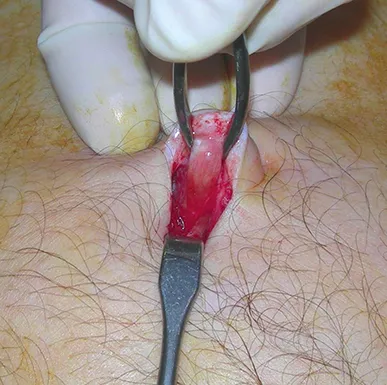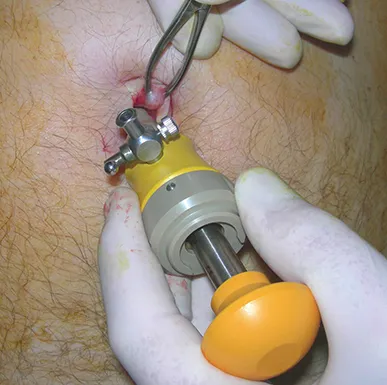
This is a test
- 224 pages
- English
- ePUB (mobile friendly)
- Available on iOS & Android
eBook - ePub
Book details
Book preview
Table of contents
Citations
About This Book
This superb, full-colour, visual revision aid has been designed specifically to candidates of the Member of the Royal College of Surgeons (MRCS) examination. It is also an invaluable diagnostic aid for all medical students and trainees, especially those on surgical rotations. Questions are based on a single clinical picture with comprehensive answers overleaf. Topics covered by this volume include laparoscopic surgery, upper and lower GI endoscopy, colorectal surgery and urology.
Frequently asked questions
At the moment all of our mobile-responsive ePub books are available to download via the app. Most of our PDFs are also available to download and we're working on making the final remaining ones downloadable now. Learn more here.
Both plans give you full access to the library and all of Perlego’s features. The only differences are the price and subscription period: With the annual plan you’ll save around 30% compared to 12 months on the monthly plan.
We are an online textbook subscription service, where you can get access to an entire online library for less than the price of a single book per month. With over 1 million books across 1000+ topics, we’ve got you covered! Learn more here.
Look out for the read-aloud symbol on your next book to see if you can listen to it. The read-aloud tool reads text aloud for you, highlighting the text as it is being read. You can pause it, speed it up and slow it down. Learn more here.
Yes, you can access MRCS Picture Questions by Tjun Tang, Bandipalyam Vamana Rao Praveen in PDF and/or ePUB format, as well as other popular books in Medicine & Medical Theory, Practice & Reference. We have over one million books available in our catalogue for you to explore.
Information
Section 1
Laparoscopic surgery
Case 1
The following pictures demonstrate the initial approach to a laparoscopic operation.

Figure 1.1a

Figure 1.1b

Figure 1.1c
Questions
Q1 Which technique for access to create a pneumoperitoneum is shown in Figures 1.1a–c?
Q2 Which anatomical structures need to be identified when applying it?
Q3 What alternative technique was widely used before this access?
Answers
A1 The Hasson, or ‘modified’ Hasson technique.
A2 The umbilicus and its insertion into the linea alba. The incision is made at this point, and the peritoneum punctured under direct vision to gain intraperitoneal access. A blunt trocar is then inserted and the abdomen insufflated with CO2 under direct vision.
A3 The Veress needle puncture. This is still used in some centres but concern has been raised over its technique of ‘blind’ puncture, which can result in increased risk of bowel or vascular trauma.
Case 2
Figure 1.2 shows part of a stack used in laparoscopic surgery, the ‘endoflator’. It is important to know how this equipment works.

Figure 1.2
Questions
Q1 Describe the function of each of the columns labelled A, B, C.
Q2 What does the display to the left of ‘A’ indicate?
Q3 What might cause the left-hand LED in ‘A’ to rise sharply during surgery?
Answers
A1 This unit controls CO2 insufflation. ‘A’ indicates the pressure level within the abdomen and allows the constant pressure to be set at a particular limit. Here it is set at 12 mmHg (right-hand LED). The actual abdominal pressure is indicated by the left-hand LED, zero at present as the unit is disconnected. ‘B’ indicates gas flow rate, usually set at 6–10 Litres/minute. Once the abdomen has reached its preset pressure the flow rate falls to zero. When gas escapes, reducing the pressure, this is detected by the unit and the flow restarts. ‘C’ indicates the total amount of gas used.
A2 This shows how much gas remains in the cylinder, and turns red when it is running low.
A3 A sudden rise would be accompanied by an alarm signal, and indicates a sudden rise in the intra-abdominal pressure. A common cause of this is the patient beginning to wake up with the return of voluntary abdominal wall contraction (this is often an earlier ‘warning signal’ for the anaesthetist than the anaesthetic machine responses!). It may also happen with a mechanical block to the gas pipe (e.g. the tap is turned off).
Case 3
A diagnostic laparoscopy was undertaken for acute-onset right upper abdominal pain in a 17-year-old female patient. The ultrasound scan was normal.

Figure 1.3
Questions
Q1 Figure 1.3 shows the view towards the right lobe of the liver. What pathology is shown on the picture?
Q2 What underlying disease is likely to have caused it?
Q3 What risks are associated with this condition?
Q4 What is the appropriate management for this...
Table of contents
- Cover
- Half Title
- Title Page
- Copyright Page
- Contents
- Foreword
- Preface
- List of contributors
- Acknowledgements
- Dedications
- Section 1: Laparoscopic surgery
- Section 2: Gl endoscopy
- Section 3: Colorectal surgery
- Section 4: Urology
- Section 5: Radiology for the surgical trainee
- Reference
- Index